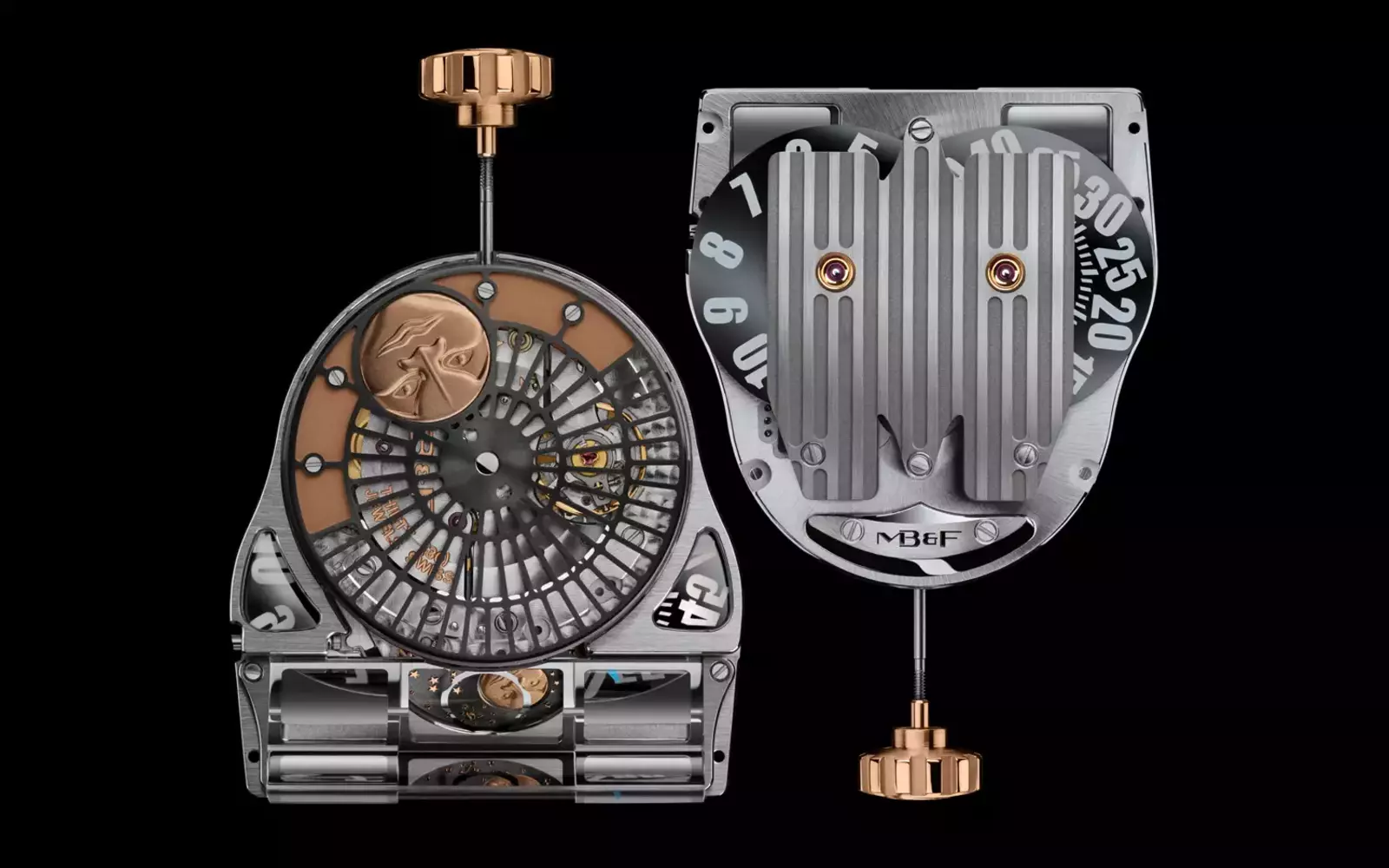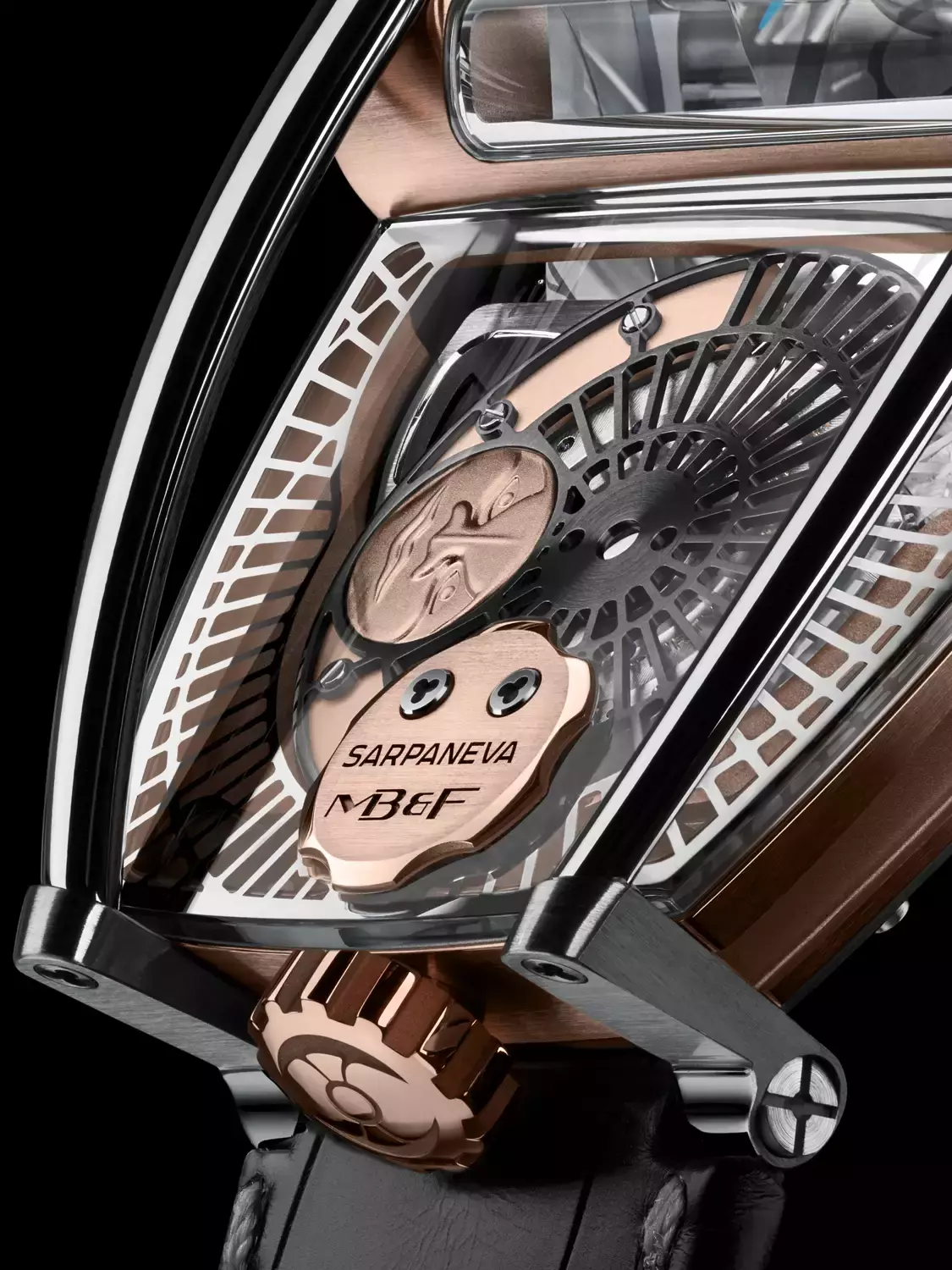
Moonmachine 2
Overview
MoonMachine 2 is the second collaboration between MB&F and Stepan Sarpaneva: a horological creation that occupies the same elusive space as moonlight, somewhere between illusion and reality. MoonMachine 2 brings us the world’s first projected moonphase display.
MoonMachine 2 comes housed in the case of Horological Machine Nº8. The stripped-down case construction of HM8 emphasised the illusory nature of the projected hours and minutes, and MoonMachine 2 uses the same mechanism to highlight the visual impact of a moon disc.
The projection is accomplished via an optical prism, which refracts vertically the hours, minutes and moon discs. A pusher on the side allows quick and easy adjustment of the moonphase display.
The battleaxe rotor of HM8 has been transformed into an openworked radial web of titanium with Sarpaneva’s signature golden moon, and the sapphire crystal pane has been metallised in a similar pattern.
About the collaboration
“Max and I have a very long friendship, and there is a lot of honesty between us. He pushes me to do better and gives me the most challenging projects. This time the challenge was to augment HM8, which is not easy. But it’s fun, and that’s why I say yes to any project with Max.”
Stepan Sarpaneva

FIRST PROJECTED MOONPHASE DISPLAY
MoonMachine 2 uses the same mechanism than the projected hours and minutes of the HM8 to highlight the visual impact of a moon disc appearing in a space too small to fully contain it.

WINDING ROTOR
The battle-axe rotor of HM8 has been transformed into an openworked radial web of titanium, echoing the design vocabulary of Stepan Sarpaneva’s best-known work.

SAPPHIRE CRYSTAL
The sapphire crystal framing the top of the engine has been metallised in the same pattern as the rotor, drawing focus to the variable sheen of the brushed titanium rotor as it rotates.
Machine in action
As strange as it might sound, moonlight doesn’t exist. It is an illusion, and even the word “moonlight” is misleading. The moon gives off no light of its own, it only reflects light from the sun. In effect, moonlight is sunlight, projected onto Earth via the moon.
If there’s one person who can be relied upon to thoroughly grasp this concept, it’s Stepan Sarpaneva, the independent Finnish watchmaker whose work has become synonymous with the moonphase display. Little wonder, then, that the second collaboration between MB&F and Stepan Sarpaneva has resulted in a horological creation that occupies the same elusive space as moonlight, somewhere between illusion and reality. The MB&F MoonMachine 2 brings us the world’s first projected moonphase display..
THE MACHINE
A rewarding collaborative project
The Legacy Machine 101 distils the very quintessence of mechanical watchmaking: the balance wheel, the power reserve and the passing of time. It is therefore no coincidence that MB&F has chosen to revisit this model – one of the purest and "simplest" in its collection – since it is indeed minimalism that guided the creation of the LM101 MB&F x H. Moser model. Like H. Moser & Cie. and the “back to basics” approach embodied in its Concept watch series, MB&F has chosen to remove its logo and return to its roots and indeed to the very origins of horology, when only the movements were signed.
- Material: Available in 4 limited editions of 15 pieces each in stainless steel 316, with fumé dials in Funky Blue, Red, Cosmic Green and an Aqua Blue edition exclusively for Ahmed Seddiqi & Sons.
- Dimensions: 40mm x 16mm
- Number of components: 35
- Water resistance: water resistant to 3 ATM / 30m / 100 feet
- Three-dimensional horological movement developed in-house by MB&F
- Movement aesthetics and finishing specifications: Kari Voutilainen
- Manual winding with single mainspring barrel
- Bespoke 14mm flying balance wheel with double hairspring
- Balance frequency: 2.5Hz / 18,000 bph
- 221 components / 23 jewels / 45 hours power reserve
- Hours, minutes and power reserve indicator

Inspiration
In 2012, when the first MoonMachine was presented, the MB&F-Sarpaneva connection was the first time that a piece of MB&F Performance Art had been produced in conjunction with another watchmaker.
The evolution of this partnership is represented by the advancement between the first MoonMachine, which was based on the HM3 Frog, and MoonMachine 2. They both utilise the rotor and moonphase display as locus points for incorporating the Sarpaneva contribution, but MoonMachine 2 takes this seemingly straightforward addition and gives it an exponential bump: a world premiere, the first ever projected moonphase display.
Maximilian Büsser and Sarpaneva began talking of a sequel to MoonMachine not too long after its release, when HM5 was announced; Stepan suggested that a moonphase indication could go between the hours and minutes of the first Horological Machine to use the optical prism display. It wasn’t until HM8, however, four years after MoonMachine, that this became more than a suggestion and laid the foundations for MoonMachine 2.








